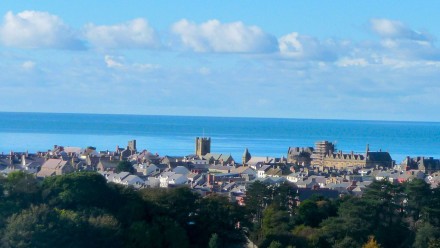
The Welsh local government reorganisation of 1974 created eight county councils and 37 district councils. Then 22 principal areas were formed, and it is those unitary authorities by which Wales has been governed since 1996.
Both the Williams Commission established by Carwyn Jones and subsequent proposals put forward by Leighton Andrews as public services minister have recommended reducing the number of Welsh local authorities further still.
Local government mergers are again being considered and there is a political consensus that we need larger local authorities, although calling a reconstituted Dyfed a local council does seem – to me at least – a little strange.
The current size of local authorities in Wales are shown below.
| Rank | District | Population |
| 1 | Cardiff | 361,500 |
| 2 | Swansea | 244,500 |
| 3 | Rhondda Cynon Taf | 238,300 |
| 4 | Carmarthenshire | 185,600 |
| 5 | Caerphilly | 180,500 |
| 6 | Flintshire | 154,400 |
| 7 | Newport | 149,100 |
| 8 | Bridgend | 143,200 |
| 9 | Neath Port Talbot | 141,600 |
| 10 | Wrexham | 136,700 |
| 11 | Powys | 132,200 |
| 12 | Vale of Glamorgan | 128,500 |
| 13 | Pembrokeshire | 124,000 |
| 14 | Gwynedd | 123,600 |
| 15 | Conwy | 116,500 |
| 16 | Denbighshire | 94,800 |
| 17 | Monmouthshire | 92,800 |
| 18 | Torfaen | 92,100 |
| 19 | Ceredigion | 74,100 |
| 20 | Isle of Anglesey | 69,700 |
| 21 | Blaenau Gwent | 69,600 |
| 22 | Merthyr Tydfil | 59,800 |
England and Scotland have several unitary authorities larger than Cardiff but Scotland has five smaller than Merthyr (Inverclyde, Clackmanshire, Western Isles, Orkney and Shetland) and England has one (Rutland).
If larger authorities were more efficient and effective, two things would happen: council tax would be lower and performance would be better. The larger authorities (and Powys, for which merging has not been deemed necessary) should charge the lowest amount.
Welsh government data of 2018/19 shows:
| District | Band D council tax | Relative size |
| Pembrokeshire | 994 | 13 |
| Newport | 1,057 | 7 |
| Caerphilly | 1,058 | 5 |
| Wrexham | 1,093 | 10 |
| Isle of Anglesey | 1,140 | 20 |
| Cardiff | 1,155 | 1 |
| Conwy | 1,168 | 15 |
| Flintshire | 1,178 | 6 |
| Vale of Glamorgan | 1,187 | 12 |
| Powys | 1,189 | 11 |
| Carmarthenshire | 1,197 | 4 |
| Ceredigion | 1,226 | 19 |
| Torfaen | 1,242 | 18 |
| Monmouthshire | 1,242 | 17 |
| Denbighshire | 1,248 | 16 |
| Swansea | 1,269 | 2 |
| Gwynedd | 1,301 | 14 |
| Bridgend | 1,396 | 8 |
| Rhondda Cynon | 1,406 | 3 |
| Neath Port Talbot | 1,497 | 9 |
| Merthyr Tydfil | 1,500 | 21 |
| Blaenau Gwent | 1,571 | 22 |
Whilst the two smallest authorities are in the bottom two places in terms of council tax, medium-sized authorities appear to perform better than either large or small authorities when it comes to the cost of council tax to the resident.
Does council performance show that the larger authorities by population perform best? According to the Western Mail, “the quality of services delivered by local authorities in Wales is not determined by the size of the council”.
The Western Mail figures are based on 28 indicators across the range of local government areas, including education, social care, housing, environment and transport, planning and regulatory services, leisure and culture and corporate health.
With four points on offer for councils that performed in the top quartile of each indicator, a maximum score of 112 was possible. Depending on their performance, councils scored between one and four points in each indicator.
This uses figures published in 2015/16; I will update these figures when I can access the 2016/17 figures.
| Council | Score | Relative size |
| Vale of Glamorgan | 86 | 12 |
| Denbighshire | 85 | 16 |
| Carmarthenshire | 79 | 4 |
| Pembrokeshire | 77 | 13 |
| Rhondda Cynon Taf | 77 | 3 |
| Merthyr Tydfil | 76 | 22 |
| Wrexham | 76 | 10 |
| Neath Port Talbot | 73 | 9 |
| Gwynedd | 72 | 14 |
| Flintshire | 71 | 6 |
| Caerphilly | 70 | 5 |
| Conwy | 68 | 15 |
| Isle of Anglesey | 68 | 29 |
| Blaenau Gwent | 67 | 21 |
| Bridgend | 67 | 8 |
| Monmouthshire | 66 | 17 |
| Newport | 66 | 7 |
| Torfaen | 66 | 18 |
| Cardiff | 64 | 1 |
| Ceredigion | 61 | 19 |
| Powys | 61 | 11 |
| Swansea | 59 | 2 |
From this data, it is not possible to conclude that larger councils and Powys perform better, with medium-sized authorities taking three of the top four places.
In Scotland, the variation in council tax is much less than Wales but the lowest council tax is in the Western Islands and Shetland, while the largest council – Glasgow – has the highest band D council tax.
I look forward to reading an explanation how larger councils perform better.
Mike Hedges is AM for Swansea East.




More from LabourList
Nudification apps facilitate digital sexual assault – and they should be banned
Diane Abbott suspended from Labour after defending racism comments
Labour campaign groups join forces to call for reinstatement of MPs